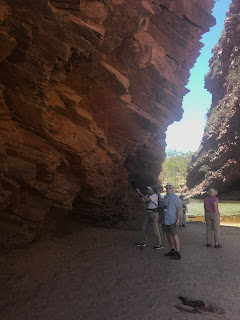Alice Springs Desert Park
We left early this morning for the Alice Springs Desert Park. When in the desert, go early. Martin, our site-coordinator led us along the marked areas and pointed out indigenous flora and fauna. What has surprised me here is how green it is, how many large trees there are and how much water there is. It is a land of droughts and flooding rains with a yearly average rain fall of 10 inches. There was a great aviary and nocturnal house where we saw marsupials and reptiles that only come out at night and got our first sighting of an Australian bat. I was constantly seeking shade as we stopped to talk about species. I’m really still amazed that trees can live here. The majority of trees are eucalyptus and desert oak (which is not an oak at all but named by settlers). I learned about the witchetty grub that lives among and eats the roots of the acacia shrub. The aboriginals eat them. I was inspired later to buy a piece of aboriginal designed cloth with witchetty grubs on it. This was the first day we needed to wear our bug nets. The little black flies were after us.
Simpson’s Gap
After lunch we traveled to Simpson’s Gap which is in the MacDonnell mountain range that surrounds Alice Springs. We hiked into the Gap where a permanent waterhole sits under the towering cliffs. Black-footed wallabies live here. This place was the Aboriginal mythological home of a group of giant goanna ancestors and remains a spiritual site to them. Aboriginals have Dreaming stories that explain how they and the world came to be. These stories are tied to the land. At Simpson’s Gap, Martin pointed out specific marks, ridges, holes in the cliff that told the story of the giant goannas. It’s a fascinating culture.
We left Simpson’s Gap for the Royal Flying Doctor Service to see how they accommodate people/patients who are so very far from medical services. This stop was likely one of Road Scholar’s attempt to support a local endeavor.
Tonight we had the most interesting of dinners at Kongkas Can Cook. We learned about and ate Aboriginal traditional bush foods. No witchetty grubs, but we did have kangaroo. Many of the berries and seed are so potently savory. Ray Lee Brown of Aboriginal decent owns the restaurant and is determined to make a go of this industry through employing Aboriginal women to gather and protect the plants. Pictures at flickr.

